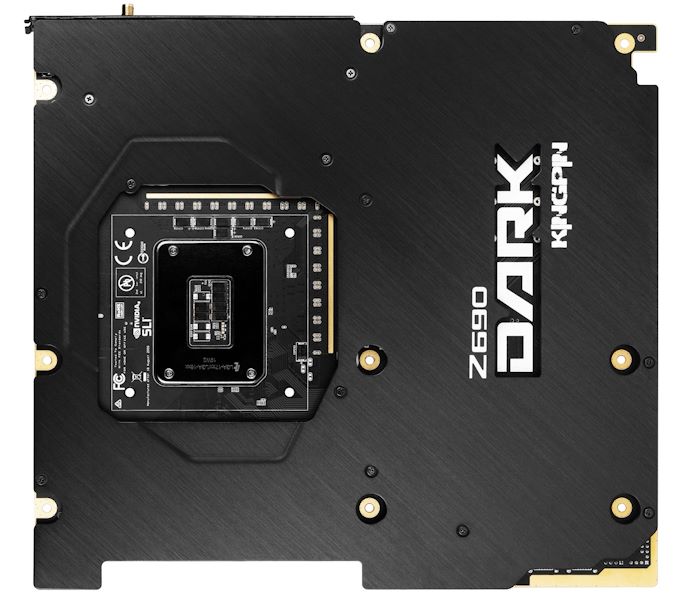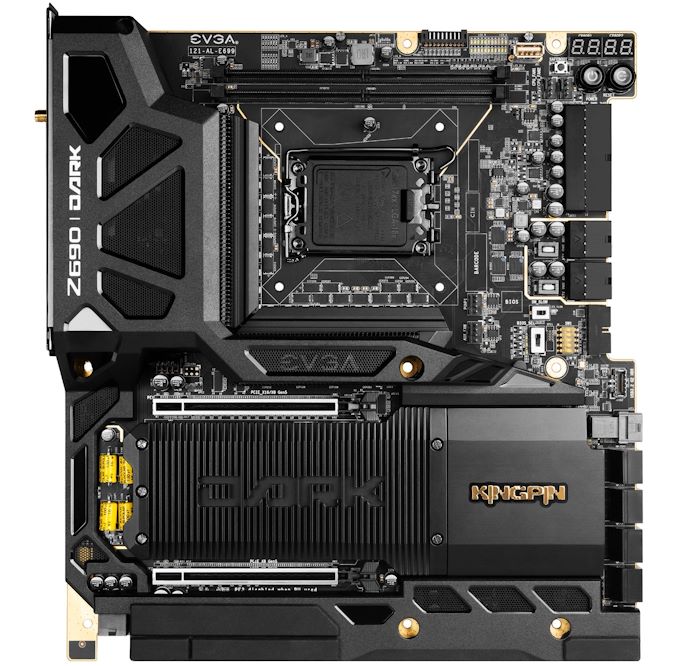The Intel Z690 Motherboard Overview (DDR5): Over 50+ New Models
by Gavin Bonshor on November 9, 2021 9:00 AM ESTEVGA Z690 DARK K|NGP|N Edition (DDR5)
Usually unveiled later on in Intel's chipset product cycles, EVGA has announced that it will be bringing two Z690 models to market sometime in the near future. The first of these is the EVGA Z690 Dark K|NGP|N edition, which is primarily geared towards extreme overclocking, just as previous versions have been. Unlike the Z590 Dark we reviewed, the Z690 model has been endorsed by legendary overclocker and in-house technician Vince Lucido.
Designed around the premium Intel Z690 chipset, the EVGA Z690 Dark K|NGP|N Edition isn't a conventional motherboard by any stretch of the imagination. It is based on the E-ATX form factor and has some interesting design characteristics including a transposed LGA1700 socket that allows extreme overclockers to mount LN2 pots with ease.
This also includes right-angled connectors including two 8-pin 12V ATX CPU power inputs, a 24-pin 12V ATX motherboard power input which intrudes into the PCB with a handy cutout designed to make cable management easier. To make the board more robust, EVGA includes a large black metal backplate on the rear of the board to reinforce the PCB, and it also includes an impressive accessories pack that features an EVGA flat test bench plate that we saw in our previous review of the EVGA Z590 Dark motherboard.
Looking at the feature set, the Z690 Dark K|NGP|N Edition includes two full-length PCIe 5.0 slots that can operate at x16 and x8/x8, with three PCIe 4.0 x4 M.2 slots that sit in between the PCIe slots and underneath a large black finned 'Dark' branded heatsink. For conventional storage and optical drives, there are eight SATA ports, six of which are from the chipset with RAID 0, 1, 5, and 10 support, as well as two that come via an ASMedia ASM1061 SATA controller.
Even though the Z690 Dark has a solid feature set for enthusiasts, the real focus by EVGA with this model is on extreme overclocking. This includes a large 21-phase power delivery cooled by an active heatsink with two fans. It also has a 10-layer PCB throughout and contains an overclocker's toolkit in the top right-hand corner that consists of dual two-digit LED debuggers, a power button, a reset button, dip-switches to disable PCIe slots, and a slow mode switch. There's also a probelt header where users can monitor voltages in real-time from various components on the board such as the CPU and power inputs.

The large black metal backplate on the rear of the EVGA Z690 Dark K|NGP|N Edition
In terms of connectivity, there's plenty on the rear panel including one USB 3.2 G2x2 Type-C, four USB 3.2 G2 Type-A, and two USB 3.2 G1 Type-A ports. For networking, EVGA is using two Intel I225-V 2.5 GbE controllers and includes Intel's latest AX211 Wi-Fi 6E CNVi. Despite a focus on performance, EVGA has also gone with a premium audio solution, including a Realtek ALC1220 HD audio codec and an EVGA NU Audio SV3H615 headphone amplifier with five 3.5 mm audio jacks and a single S/PDIF optical output.











126 Comments
View All Comments
DanNeely - Tuesday, November 9, 2021 - link
Good point. I thought Intel was pushing hard for 12vo with the 6xx series, but it seems to be completely MIA.Silver5urfer - Tuesday, November 9, 2021 - link
Can I ask why ? What does ATX12VO provide to a consumer ?It doesn't make your mobo cheap, it doesn't make your mobo less complicated, it does not make your system run cooler, it doesn't make ADL consume less power, It doesn't even make any sense.
ATX12VO was created because of that trash policies set by policing state of California about some nonsensical rubbish. Servers and Data centers can get away with modular high density PSUs because of fully standardized set and they also get 3M liquid cooling. This is consumer market and here we have people wishing for backwards in technology.
meacupla - Thursday, November 11, 2021 - link
A lot of people had the same sentiment about EU RoHS restrictions, and yet, it was implemented worldwide.With that attitude, the same can be said about energy star, and 80plus certifications. It adds cost to the product, yet it offers not a thing to the consumer.
Not everything is about you.
We need to do everything we can to cut down power consumption, and ATX12VO standardization across the entire industry is very low hanging fruit.
Stop being so selfish, there's literally only one habitable planet we have right now.
Oxford Guy - Thursday, November 11, 2021 - link
80 Plus offered plenty to consumers. Less power use means quieter PSUs.The knock on 80 Plus was unrealistically easy testing. Despite that, it helped raise the efficiency of PSUs. Along with better efficiency, ripple, holdout time, voltage consistency, and other factors improved — as enthusiasts began to pay more attention to PSU quality.
I don’t doubt that 80 Plus also helped a lot of non-enthusiasts/amateurs by keeping them away from ultra-cheap PSUs that catch fire. Having a high-profile certification that those PSUs can’t reach helped to steer those customers away.
yacoub35 - Tuesday, November 9, 2021 - link
That white metal trim running tight around the molex power connector on the ASUS ROG Maximus Z690 Formula must make it an absolutely nightmare to plug/unplug the main power cable to the board.Ranguvar - Tuesday, November 9, 2021 - link
Correction:"Previously with 11th gen (Rocket Lake), Intel upheaved it from a PCIe 3.0 x4 uplink on Z490 to a PCIe 3.0 x4 uplink on Z590."
This should say "to a PCIe 3.0 x8 uplink on Z590".
OFelix - Tuesday, November 9, 2021 - link
Correct. And whilst we are correcting that sentence - "upheaved" ????This first page really needs to be read by an AnandTech editor.
What's that? They don't any editors? :-(
OFelix - Tuesday, November 9, 2021 - link
"Z490 Motherboard Audio" ... presumably Z690?mode_13h - Friday, November 12, 2021 - link
I caught that, as well. Even the word "upheaved" is itself somewhat noteworthy. Plenty of better alternatives: "upgraded", "widened", "expanded", "increased", "enlarged", etc.GeoffreyA - Saturday, November 13, 2021 - link
While "upheaved" is likely an error, it's not far off from the words of today. Unfortunately, the English language is on a downgrade, and it's just going to get worse and worse. The language's genius is not tuned to the over-economical forms we're finding today; and a lot of it seems to be coming from tech. Upthis, upthat. My favourite, though, is leverage. A big, scary word that companies are fond of, and which escaped its programming, game development roots. Soon, we'll be leveraging the kettle to make tea. How about using?